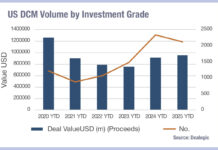So-called ‘interdealer’ markets have long been used by large buy-side firms. This well-known secret creates inequality for those investment firms barred from participating, and for banks who have to engage with ‘buy-side’ firms unfettered by the capital restraints facing sell-side firms.
Some of these buy-side interdealer market participants hold assets for the same time – or less – than dealers. As such their status as ‘investors’ is questionable. A principal trading firm (PTF) that buys and sells at higher average daily volumes (ADVs) than a market maker and holds no inventory overnight looks, walks and quacks like a market maker. It looks nothing like a pension fund.
The Securities and Exchange Commission (SEC) has proposed a pair of rules directed at bringing PTFs into line with the regulatory requirements levelled on sell-side firms, in the US Treasury market, via Exchange Act Rules 3a5-4 and 3a44-2.
A new report by Audrey Blater, senior analyst, risk and financial markets regulation and Coalition Greenwich has published a report on the issue, ‘Examining the SEC’s US Treasury Nonbank Dealer Registration Proposal’.
In it she notes the proposal of 28 March 2022, says firms providing liquidity and other dealer-like functions “would be required to “register with the SEC, become members of a self-regulatory organisation (SRO), and comply with federal securities laws and regulatory obligations.”
“Buy-side engagement in the interdealer market has been going on long before 2014 by at least a decade, when I worked on a trading desk,” says Blater. “Some firms are big enough that dealers are prepared to look the other way. There were formerly fairly well-established lines between the interdealer and client markets, but dealers can’t get too mad at a massive investment firm in the interdealer market because they are a client.”
This blurring of the lines created greater concern amongst banks after adequacy capital regulation, which determines the amount of capital they need to balance against risks being taken, increased.
“This is bad for America, as it handicaps regulated banks at precisely the wrong time, causing them to be capital constrained and reduce growth in areas like lending, as the country enters difficult economic conditions,” wrote Jamie Dimon in recent testimony to the House committee on financial services.
The effect in Treasury markets has been to reduce traditional makrt amkgin activity at key points of illiquidity, which is when it is needed most.
“The market can become broken as we saw during COVID, when we saw how important it became to have non-bank liquidity,” says Blater. “FRTB is right around the corner, currently likely in 2025, at which point more money will be dumped into regulatory compliance, while PTFs coming in don’t have to do that.”
In the report, she wrote, “It is clear the Commission may not appreciate how far the proposed rules go, as well as their potential for tearing down a functioning market structure in US Treasury securities. For instance, some private funds and investment advisors could be dragged into the regulation because they trigger the threshold requirements. Under Rule 3a44-2, transacting in more than $25 billion of trading volume in US Treasury securities in four out of six calendar months is determined to be “a part of regular business” and subject to the proposed rules.”
She added that this was seen by market participants as “intentionally low to capture any firm attempting to restructure their business to circumvent the rules”
This volume represents 0.0625% of the volume, while PTFs are estimated to provide nearly 20% of volume in interdealer markets.
All-to-all markets have been successful in credit and FX,and have been proposed for rates markets as well. Ultimately while the SEC may be pushing for greater delineation, the facts may prove that no clear delineation on buy- and sell-side really exists any more.
“The lines become blurred until we end up with one market at some point. I’m sure that will be the future, with one market,” says Blater.
©Markets Media Europe 2025













